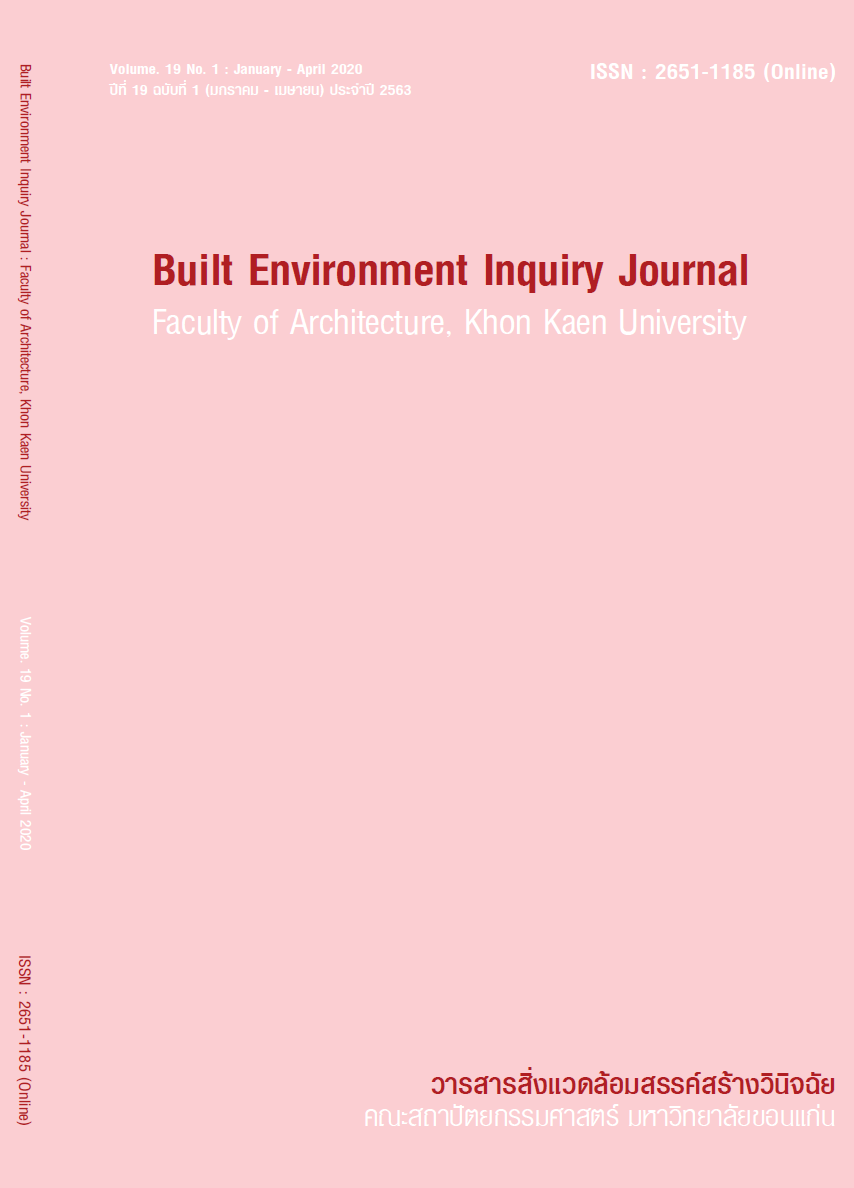ปัจจัยทางกายภาพที่ส่งเสริมการปฏิสัมพันธ์ในพื้นที่ส่วนกลางของโฮสเทลในกรุงเกียวโต ประเทศญี่ปุ่น
คำสำคัญ:
โฮสเทล พื้นที่ส่วนกลาง การปฏิสัมพันธ์ ภูมิทัศน์บริการ เกียวโตบทคัดย่อ
ตลาดโฮสเทลเชียงใหม่ในปัจจุบันมีการแข่งขันสูง แต่ส่วนใหญ่แข่งขันกันด้วยราคาทำให้ราคากลางของโฮสเทลมีราคาต่ำและมีแนวโน้มลดลง ในขณะเดียวกัน ตลาดโฮสเทลในกรุงเกียวโต ประเทศญี่ปุ่น กลับแข่งขันกันด้วยคุณภาพ (โนกามิ, 2019) ผู้วิจัยจึงต้องการทราบแนวทางส่งเสริมคุณภาพของโฮสเทลในกรุงเกียวโตผ่านงานวิจัยนี้ โดยมีวัตถุประสงค์เพื่อศึกษาลักษณะสภาพแวดล้อมทางกายภาพที่ส่งเสริมการปฎิสัมพันธ์ของลูกค้าในพื้นที่ส่วนกลางของโฮสเทล เก็บข้อมูลโดยการสำรวจลักษณะสภาพแวดล้อมทางกายภาพ และการสังเกตพฤติกรรมของลูกค้าที่มาใช้บริการภายในพื้นที่ส่วนกลางของโฮสเทลชั้นนำ ในกรุงเกียวโต ซึ่งได้รับการเสนอชื่อจาก HOSCARs awards ให้เป็นโฮสเทลที่ดีที่สุด จำนวน 5 แห่ง (โฮสเทลเวิร์ด, 2019) และนำมาเปรียบเทียบเพื่อแสดงลักษณะทางกายภาพที่มีความสัมพันธ์กับการปฏิสัมพันธ์ของลูกค้าผลการศึกษาพบปัจจัยทางกายภาพที่มีความสัมพันธ์ระหว่างการตอบสนองทางพฤติกรรมและการปฏิสัมพันธ์สามกลุ่ม คือ 1) ปัจจัยที่ส่งเสริมการเข้าใช้พื้นที่ ได้แก่ การกำหนดสัดส่วนผู้เข้าพักให้มีจำนวนเตียงในห้องพักแบบแชร์ห้องน้ำมากกว่าแบบที่มีห้องน้ำในตัว เป็นโฮสเทลขนาดเล็กรองรับลูกค้าไม่เกิน 75 เตียง มีพื้นที่ส่วนกลางประมาณ 1.16 ตารางเมตรต่อผู้เข้าพัก 1 คน มีกิจกรรมที่เปิดโอกาสให้บุคคลภายนอกใช้พื้นที่ร่วมกับลูกค้าโฮสเทลได้สะดวกและต่อเนื่อง เป็นทางเข้าเดียวกันกับทางเข้าอาคาร เพื่อผ่านไปสู่พื้นที่อื่นๆ ของอาคาร และสามารถมองเห็นและเข้าถึงพื้นที่ส่วนกลางได้โดยง่าย 2) ปัจจัยที่ส่งเสริมการเกิดกิจกรรมทางสังคมโดยรวมภายในพื้นที่ทั้งหมด ได้แก่ การไม่ใช่วัสดุไม้กับพื้นผิวพื้นที่ การจัดให้มีฟังก์ชั่นที่ส่งเสริมให้ลูกค้าได้พูดคุยกับพนักงาน เช่น แผนกต้อนรับ คาเฟ่ และบาร์ และการจัดให้จำนวนที่นั่งที่เพียงพอแก่ลูกค้า 3) ปัจจัยที่ส่งเสริมการเกิดกิจกรรมทางสังคมเฉพาะบริเวณที่นั่ง ได้แก่ การออกแบบที่นั่งให้คนอยากนั่งเช่น การใช้สีที่นั่งโทนอบอุ่น เก้าอี้ไม้ โต๊ะไม้ การออกแบบที่นั่งที่ส่งเสริมให้เกิดการสนทนา เช่นการจัดให้ที่นั่งสามารถเข้าถึงได้ง่ายจากทางสัญจรหลัก หันหน้าไปสู่ด้านที่มีคน มีระดับความสูงไม่แตกต่างมากระหว่างคนนั่งและคนยืน และการออกแบบที่นั่งที่สร้างสภาพแวดล้อมที่เหมาะต่อการสนทนา เช่นที่นั่งบริเวณที่แสงน้อย ที่นั่งที่สามารถเคลื่อนย้ายได้ ไม่มีพนักพิง ใช้วัสดุที่นั่งแบบแข็ง และมีขนาดเล็ก ผลจากการศึกษามีประโยชน์ต่อเจ้าของกิจการและนักออกแบบที่ต้องการส่งเสริมให้เกิดการปฏิสัมพันธ์ของลูกค้าภายในพื้นที่ส่วนกลางของโฮสเทล อันเป็นหนึ่งในปัจจัยที่เพิ่มคุณภาพของประสบการณ์ นำไปสู่ความพึงพอใจในการเข้าพักของลูกค้า ซึ่งนำไปสู่ความสำเร็จและทำให้โฮสเทลสามารถแข่งขันด้วยคุณภาพโดยไม่ต้องลดราคา
เอกสารอ้างอิง
Arnould, E., & Price, L. L. (1993). River magic: Extraordinary experience and the extended service encounter. Journal of Consumer Research, 20(1). 24-45.
Baker, J., Grewal, D., & Parasuraman, A. (1994). The influence of store environment on quality inferences and store image. Journal of the Academy of Marketing Science, 22(4), 328-339.
Bennett, D. J., & Bennett, J. D. (1970). Making the scene. In G. Stone & H. Farberman (Eds.), Social psychology through symbolic interactionism (pp. 190–196). Waltham, MA: Ginn- BlaisdellBitner, M. J. (1992). Servicescapes: The impact of physical surroundings on customers and employees. The Jounal of Marketing, 56, 57-71.
Bowie, D., & Buttle F. (2011). Hospitality marketing principles and practice (2nd ed). Spain: Elsevier. C9 Hotelworks Market Research. (2018). C9 SE Asia hostel market update: January 2018.Retrieved from https://www.c9hotelworks.com
Donovan, R. J., & Rossiter, J. R., (1982). Store atmosphere: An environmental phychology approach. Journal of Retailing, 58(1), 34-57.
Economic Intelligence Center. Thai tourism: Sustaining success. Insight. Retrieved from https://www.scbeic.com
Fishman, E. (2016, July 5). [Web log message]. Retrieved from https://wistia.com
Holahan, C. J. (1971). Seating patterns and patient behavior in an experimental dayroom (Unpublished doctoral dissertation). University of Massachusetts.
Holahan, C. J., & Rudolf, H. M. (1982). Social support and adjustment: Predictive benefits of social climate indices. American Journal of Community Psychology, 10(4), 403-415.
Hostelworld (2019, January 28). The world’s best hostels voted by you [Web log message]. Retrieved from https://www.hostelworld.com/hoscars
Houston, D., Williams, S. L., Bloomer, J., & Mann, W. C. (1989). The bay area functional performance evaluation: Development and standardization. American Journal of Occupational Therapy, 43, 170-183.
Huang, J., & Hsu, C. H. (2009a). The impact of customer-to-customer interaction on cruise experience and vacation satisfaction. Journal of Travel Research, 49(1), 79-92.
Huang, J., & Hsu, C. H. (2009b). Interaction among fellow cruise passengers: Diverse experiences and impacts. Journal of Travel & Tourism Marketing, 26(5-6), 547-567.
Jarvis, J., & Peel, V. (2010). Beyond backpacker tourism: Mobilities and experiences. Bristol: Channel view.
Kotler. P. (1973). Atmospherics as a marketing tool. Journal of Retailing, 49(4), 48-64.
Lovelock, C. (1994). Product Plus. New York, NY: McGraw-Hill.
Martin, C. L. (1996). Consumer-to-consumer relationships: Satisfaction with other consumers’ public behavior. Journal of Consumer Affairs, 30(1), 146-169.
Mehrabian, A., & Russell, J. A. (1974). An approach to environmental psychology. Cambridge, MA: MIT Press.
Murphy, L. (2001). Exploring social interactions of backpackers. Annals of Tourism Research. 28(1), 50-67.
Musa, G., & Thirumoorthi, T. (2011). Red palm: Exploring service quality and servicescape of the best backpacker hostel in Asia. Current Issues in Tourism, 14(2), 103-120.
Nogami, C. (2019, March 19). Interview. Planning and general affairs, Backpacker Japan company.
O’ Regan, M. (2010). Beyond backpacker tourism. In K. Hannam & A. Diekmann (Eds.). Backpacker Hostels: Place and Performance (pp. 85-101). Clevedon: Channel View.
Parasuraman, A., Berry, L. L., & Zeithamal, V. A. (1988). SERVQUAL: A multiple-item scale for measuring consumer perceptions of service quality. Journal of Retailing, 64(1), 12-40.
Paris, C. M. (2012). Flashpackers: An emerging sub-culture?. Annals of Tourism Research.39(2), 1094-1115.
Pearce, D., & Turner, R. K. (1990). Economics of natural resources and the environment. Baltimore, MD: Johns Hopkins University Press.
Prideaux, B., & Shiga, H. (2007). Japanese backpacking: The emergence of a new market sector—A Queensland case study. Tourism Review International, 11(1), 45-56.
Rashid-Radha, J. (2015). The Influence of Hostel Servicescapes on Social Interaction and Service Experience .Unpublished doctoral dissertation, School of Hospitality and Tourism Management, University of Surrey, England.
Russo, A. P., & Richards, G. (2016). Reinventing the local in tourism: Producing, consuming and negotiating place. Bristol: Channel View
SCB SME. (2017, September 28). [Web log message]. Retrieved from https://businesslinx.globallinker.com
Tombs, A., & McColl-Kennedy, J. R. (2003, December). Customers as spatial and social influences on other customers in the sicial servicescape. Paper presented at the Australian and New Zealand Marketing Academy Conference (ANZMAC2003). Adelaide, Australia.
Tombs, A., & McColl-Kennedy, J. R. (2010). Social and spatial influence of customers on other customers in the social servicescape. Australasia Marketing Journal, 18(3), 120-131.
UNWTO World Tourism Organization. (2018). UNWTO Tourism Highlights. Retrieved from https://www.e-unwto.org/doi/pdf/10.18111/9789284419876
Wakefield, K. L., & Blodgett, J. G. (1996). The effect of the servicescape on customers’ behavioral intentions in leisure service settings. Journal of Services Marketing, 10(6), 45-61.
Wakefield, K. L., & Blodgett, J. G. (1999). Customer response to intangible and tangible service factors. Psychology & Marketing, 16(1), 51-68.
WYSE Travel Confederation. (2016, March). Global report on the power of youth travel 2016.Retrieved from http://cf.cdn.unwto.org/sites/all/files/pdf/wyse_powerofyouthtravel.pdf
Yokdee, J. (2019, January 10). Interview. Managing Director of Oxotel Hostel Chiang Mai.
Zhang, L., Helander, M. G., & Drury, C. G. (1996). Identifying factors of comfort and discomfort in sitting. HumanFactors The Journal of the Human Factors and Ergonomics Society, 38(3), 377-389.
ดาวน์โหลด
เผยแพร่แล้ว
รูปแบบการอ้างอิง
ฉบับ
ประเภทบทความ
สัญญาอนุญาต
ทัศนะและข้อคิดเห็นของบทความที่ปรากฏในวารสารฉบับนี้เป็นของผู้เขียนแต่ละท่าน ไม่ถือว่าเป็นทัศนะและความรับผิดชอบของกองบรรณาธิการ




